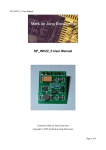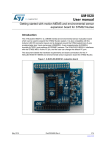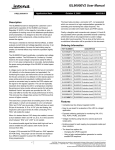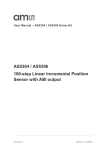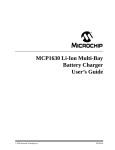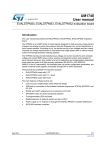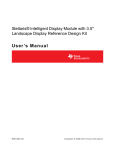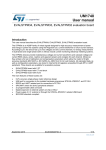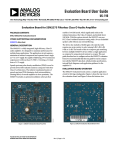Download Si86xxISO-EVB User's Guide
Transcript
Si86xxISO-EVB UG Si86 XX ISO E VALUATION B OAR D U SER ’ S G UIDE 1. Introduction The Si86xxISO evaluation board allows designers to evaluate Silicon Lab's family of CMOS ultra-low-power isolators. These isolators are CMOS devices employing RF coupler technology to transmit digital information across an isolation barrier. Very high speed operation at low power levels is achieved. These products are based on Silicon Laboratories’ proprietary RF isolation technology and offer shorter propagation delays, lower power consumption, improved noise immunity, smaller installed size, and more stable operation with temperature and age versus opto couplers. The Si861x/2x/3x/4x/5x/6x include up to six unidirectional isolated channels, permitting data transmission up to 150 Mbps. The Si860x isolator series consists of single-package galvanic isolation solutions for I2C, SMBus, and PMBus serial port applications. For more information, refer to the respective family data sheets. A summary of the benefits provided by the Silicon Laboratories Si86xx CMOS Digital Isolator family includes: Si86xx Digital Isolators 5.0 kV, 3.75 kV, and 1.0 kV isolation ratings CSA, and VDE certifications DC to 150 Mbps 2.5 to 5.5 V VDD supply range Fail-safe operating mode(s) –40 to 125 °C temperature range 10 ns max propagation delay <1.5 mA/channel @ 1 Mbps <1.5 ns pulse width distortion Very low EMI Up to 50 V/m electric field immunity >1000 A/m magnetic field immunity >30 kV/µs CMTI 4 kV HBM ESD immunity UL, Si860x I2C-Compatible Bidirectional Isolators Bidirectional SDA and SCL Mbps 35 mA open drain I/O 3 to 5.5 V VDD supply range 1.7 Packaging and Isolation Rating Options WB SOIC-16 (5 kV) SOIC-16 (3.75 kV) NB SOIC-8 (3.75 kV) QSOP-16 (1 kV) RoHS compliant NB Rev. 0.2 2/11 Copyright © 2011 by Silicon Laboratories Si86xxISO-EVB UG Si86xxISO-EVB UG 2. Kit Contents The Si86xxISO Evaluation Kit contains the following items: Si86xxISO based evaluation board (Si86xxISO-EVB) shown in Figure 1. Si8600, Si8605, Si8621, Si8655, and Si8663 CMOS digital isolators installed on the evaluation board Figure 1. Si86xxISO Evaluation Board Overview 2 Rev. 0.2 Si86xxISO-EVB UG 3. Hardware Overview and Setup The Si86xxISO evaluation board is populated with the following isolators: Si8600 (2-channel I2C isolator) Si8605 (2-channel digital isolator, 2-channel I2C isolator) Si8621 (2-channel digital isolator, one forward, one reverse) Si8455 (5-channel digital isolator, five forward) Si8663 (6-channel digital isolator, three forward, three reverse) The board is designed to be powered from two separate supplies (2.5–5.5 V, 500 mA) that power all the isolators on the board. VDD1,GND1 and VDD2,GND2 power the 5 kV isolators. VDD3,GND3 and VDD4,GND4 power the 1 and 2.5 kV isolators. Supplies as low as 2.5 V can be used. If a user wants to evaluate an isolator other than the ones populated, this can be accomplished by removing the footprint-compatible device installed on the evaluation board and replacing it with the desired isolator device. Figure 2 provides a silkscreen overview of the board. Figure 2. Si86xxISO Evaluation Board Silkscreen Rev. 0.2 3 Si86xxISO-EVB UG 3.1. Digital Isolator Considerations The Si86xxISO evaluation board (see Figure 1) provides a means of evaluating the Si861x,2x,3x,4x,5x,6x digital isolator families as well as the Si8600 isolated I2C family. After power (2.5–5 V) has been supplied to the board, connect a digital input signal (5 Vpeak max, with desired clock frequency up to 150 Mbps) to the desired input channel. To view the isolated channel’s data transmission, connect a scope probe to the output channel of interest. There are various inputs and outputs on either side of the board depending on the device one chooses to evaluate, as indicated by the silk screen. The board can be used to measure propagation delay, pulse-width distortion, channel-channel matching, pulse-width skew, and various other parameters. The nominal output impedance of an isolator driver channel is approximately 50 , ±40%, which is a combination of the values of the on-chip series termination resistor and the channel resistance of the output driver FET. When driving loads where transmission line effects are a factor, output pins should be terminated with 50 controlled impedance PCB traces. Figure 3 illustrates the Si8621 transmitting a 500 kHz (3 Vpeak) signal through the Si8621. VDD1 and VDD2 were powered from 3 V. Channel 1 illustrates the input, and Channel 2 illustrates the output. Figure 3. 500 kHz (5 V Peak) Signal 4 Rev. 0.2 Si86xxISO-EVB UG 3.2. I2C Isolator Considerations After power (3–5 V) has been supplied to the board, connect a digital square wave input (5 Vpeak max, with desired clock frequency up to 1.7 MHz) to the desired input channel. The Si8600/05 I2C isolators have 1 k pull-up resistors already installed. If these resistors are redundant with another board that is being used to evaluate the Si8600/05, the user should remove the redundant pull-up resistors to accommodate adequate drive current for the test being performed. Figure 4 illustrates Side B Pulling Up, with Side A following for the Si8600. The Si8600 was powered from 3 V on both sides with a 100 kHz input test signal. Figure 4. Side B Pulling Up, Side A Following Note: The test points in front of each device have 1 mm spacing. If desired, the test points can be replaced with a 1 mm spacing terminal block to assist in evaluation. Rev. 0.2 5 J1 HDR1X4 GND_1 4 2 3 1 2 3 4 5 6 GND_1 7 J5 GND_1 C5 1.0UF GND_1 C1 1.0UF 7 6 5 4 3 2 8 6 5 4 2 A6 A5 A4 A3 A2 A1 NC ASCL ASDA NC NC 14 GND_1 8 16 VDD_2 VDD_1 U3 1 Si8663BD-B-IS GND_2 9 GND_1 7 1 U1 Si8600AD-B-IS B6 B5 B4 B3 B2 B1 10 11 12 13 14 15 10 11 12 13 15 C6 1.0UF GND_2 7 J6 GND_2 1 2 3 4 5 6 GND_2 R3 1K R4 1K 4 GND_2 3 2 1 VDD_2 J2 HDR1X4 GND_1 5 J3 HDR1X5 4 3 2 1 R5 1K R6 1K GND_1 7 6 5 4 3 2 C3 1.0UF NC ASCL ADOUT ADIN ASDA NC VDD_2 U2 Si8605AD-B-IS 16 GND_1 8 1 Figure 5. Si86xxISO Evaluation Board Schematic (1 of 2) GND_2 9 16 NC BSCL BSDA NC NC C2 1.0UF AGND 3 BGND 1 R2 1K ISOLATION ISOLATION AVDD VDD_1 ISOLATION VDD_2 BVDD BGND VDD2 VDD_1 R1 1K AGND AVDD AGND VDD1 GND1 Rev. 0.2 GND2 BVDD 6 MH2 MH3 NC BSCL BDIN BDOUT BSDA NC 10 11 12 13 14 MH4 15 GND_2 C4 1.0UF STANDOFFS AND SCREWS MH1 GND_2 9 BGND VDD_1 R7 1K R8 1K 5 GND_2 4 3 2 J4 HDR1X5 1 Si86xxISO-EVB UG 4. Si86xxISO Evaluation Board Schematics 8 2 3 4 5 6 7 GND_3 J7 1 HDR1X8 VDD_3 7 6 5 4 3 2 A6 A5 A4 A3 A2 A1 VDD1 GND_3 8 GND1 GND_3 U4 ISOLATION 1 Si8663EC-B-IS1 16 GND_4 9 B6 B5 B4 B3 B2 B1 10 11 12 13 14 15 1 8 J8 HDR1X8 GND_3 6 5 4 3 2 J9 HDR1X6 1 GND_3 C9 1.0UF 7 6 5 4 3 A5 U5 Si8655BA-B-IU GND_3 8 2 A4 A3 A2 A1 1 16 VDD_4 9 B5 B4 B3 B2 B1 GND_4 15 GND2 10 11 12 13 14 6 GND_4 5 GND_3 3 2 4 1 J11 HDR1X3 3 GND_3 C11 1.0UF VDD_3 2 1 J10 HDR1X6 GND_4 C10 1.0UF Figure 6. Si86xxISO Evaluation Board Schematic (2 of 2) GND_4 2 3 4 5 6 7 VDD_4 GND_4 C8 1.0UF ISOLATION C7 1.0UF VDD2 GND2 VDD_3 GND1 VDD1 GND1 VDD2 GND2 VDD_4 4 3 2 1 GND1 A2 A1 VDD1 U6 Si8621BC-B-IS ISOLATION VDD_3 GND2 B2 B1 VDD2 5 6 7 8 GND_4 3 2 1 J12 HDR1X3 GND_4 C12 1.0UF VDD_4 Si86xxISO-EVB UG Rev. 0.2 7 Si86xxISO-EVB UG 5. Bill of Materials Table 1. Si86xxISO Evaluation Board Bill of Materials* Item Qty Ref Part # Mfr Description 1 4 MH1–4 1902AK-ND/H542-ND Digikey Standoff, Nylon, 4–40, 1/4" HEX x 0.250" HGT or EQ, RoHS 2 12 C1–12 PCC2249CT-ND Digikey Cap 1.0 µF, X5R, Ceramic, 0805, 16 V, ±10%, OR EQ, RoHS 3 8 R1–8 RR12P1.0KBCT-ND Digikey RES, 1 k , SMT, 0805, 1/10 W, ±0.1%, OR EQ, RoHS 4 2 J11–12 S1011E-03-ND Digikey STAKE HEADER, 1x3, 0.1" CTRS, OR EQ, RoHS 5 2 J1–2 S1011E-04-ND Digikey STAKE HEADER, 1x4, 0.1" CTRS, OR EQ, RoHS 6 2 J3–4 S1011E-05-ND Digikey STAKE HEADER, 1x5, 0.1" CTRS, OR EQ, RoHS 7 2 J9–10 S1011E-06-ND Digikey STAKE HEADER, 1x6, 0.1" CTRS, OR EQ, RoHS 8 2 J7–8 S2011E-08-ND Digikey STAKE HEADER, 1X8, 0.1" CTR, GOLD, OR EQ, RoHS 9 2 J5–6 S2011E-09-ND Digikey STAKE HEADER, 1X9, 0.1" CTR, GOLD, OR EQ, RoHS 10 1 U1 Si8600AD-B-IS Silicon Labs IC, I2C ISO, 2-Ch, 2 Bidirectional, 1.7 MHz, 5 kV, SOL-16, RoHS 11 1 U2 Si8605AD-B-IS Silicon Labs IC, 4-Ch I2C ISO, 2 Bidirectional, 2 Unidirectional, 1.7 MHz, 5 kV, SOL-16, RoHS 12 1 U6 Si8621BC-B-IS Silicon Labs IC, ISOpro Low-Power 2-Channel Isolator, 150 Mbps, 3.75 kV, SO-8, RoHS 13 1 U5 Si8655BA-B-IU Silicon Labs IC, 5-Channel Digital Isolator, Low-Power, 5 Forward, 150 Mbps, 1 kV, QSOP-16, RoHS 14 1 U3 Si8663BD-B-IS Silicon Labs IC, 6-Channel Digital Isolator, Low-Power, 3 Forward/3 Reverse, 150 Mbps, 5 kV, SOL-16, RoHS 15 1 U4 Si8663EC-B-IS1 Silicon Labs IC, 6-Channel Digital Isolator, 3 Forward/3 Reverse, Low-Power, 150 Mbps, 3.75 kV, SO-16, RoHS *Note: All components on this BOM are lead free. 8 Rev. 0.2 Si86xxISO-EVB UG 6. Ordering Guide Table 2. Si86xxISO Evaluation Board Ordering Guide Ordering Part Number (OPN) Description Si86xxISO-KIT Si86xx CMOS digital isolator evaluation board kit Rev. 0.2 9 Si86xxISO-EVB UG DOCUMENT CHANGE LIST Revision 0.1 to Revision 0.2 10 Updated BOM and schematics to reflect change from Rev A to Rev B silicon. Rev. 0.2 Si86xxISO-EVB UG NOTES: Rev. 0.2 11 Si86xxISO-EVB UG CONTACT INFORMATION Silicon Laboratories Inc. 400 West Cesar Chavez Austin, TX 78701 Tel: 1+(512) 416-8500 Fax: 1+(512) 416-9669 Toll Free: 1+(877) 444-3032 Please visit the Silicon Labs Technical Support web page: https://www.silabs.com/support/pages/contacttechnicalsupport.aspx and register to submit a technical support request. The information in this document is believed to be accurate in all respects at the time of publication but is subject to change without notice. Silicon Laboratories assumes no responsibility for errors and omissions, and disclaims responsibility for any consequences resulting from the use of information included herein. Additionally, Silicon Laboratories assumes no responsibility for the functioning of undescribed features or parameters. Silicon Laboratories reserves the right to make changes without further notice. Silicon Laboratories makes no warranty, representation or guarantee regarding the suitability of its products for any particular purpose, nor does Silicon Laboratories assume any liability arising out of the application or use of any product or circuit, and specifically disclaims any and all liability, including without limitation consequential or incidental damages. Silicon Laboratories products are not designed, intended, or authorized for use in applications intended to support or sustain life, or for any other application in which the failure of the Silicon Laboratories product could create a situation where personal injury or death may occur. Should Buyer purchase or use Silicon Laboratories products for any such unintended or unauthorized application, Buyer shall indemnify and hold Silicon Laboratories harmless against all claims and damages. Silicon Laboratories and Silicon Labs are trademarks of Silicon Laboratories Inc. Other products or brandnames mentioned herein are trademarks or registered trademarks of their respective holders. 12 Rev. 0.2












